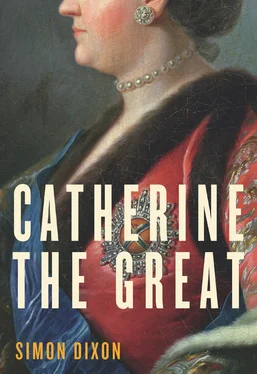PROLOGUE
The Coronation of a Usurper
1762
‘Nowhere perhaps is the vicinity of a church more disagreeable than in Russia,’ complained a Swedish prisoner of war in 1760, tormented by the ‘perpetual dinging’ from St Petersburg’s Peter-Paul Cathedral. 1its bell tower was only a few feet from his cell. Yet had Count Johann Hård been incarcerated in the moscow Kremlin, his ears would have been even sorer. While the Russians long continued to attribute magical powers to their bells, ringing them out to drive the devil from their parishes, their eighteenth-century rulers had co-opted the instrument as a symbol of the sacralisation of tsarist power. 2Empress Anna could think of no better way of adding to her glory in the 1730s than by commissioning the world’s largest bell. Fatally cracked by fire in may 1737, before it had been raised from its casting pit, tsar-kolokol —‘the tsar bell’—lay buried in the Kremlin until 1836, escaping the designs of an enterprising moscow freemason who planned to smelt it in the 1780s and use the metal for fonts to print a new children’s Bible. 3But while Hård was languishing in the Peter-Paul Fortress, Empress Elizabeth had commissioned a rival instrument, almost as massive, measuring more than forty feet in circumference. Alongside depictions of Christ, the Virgin mary and John the Baptist, the bell’s founder Konstantin Slizov had adorned it with portraits of the imperial family. His inscription drove home the dedication:
In the year from the creation of the world 7268 and from the incarnation of God the Word 1760, this bell has been cast in moscow during the prosperous reign of the most Pious and most Autocratic Great Sovereign, Yelizaveta Petrovna, Empress of All Russia, in the 19th year of her reign and in the time of their Imperial Highnesses, the gracious Lord, Grand Duke Peter Fëdorovich, and his consort, the gracious Lady, Grand Duchess YEKATERINA ALEKSEYEVNA, and in that of the gracious Lord [their son], Grand Duke PAVEL PETROVICH. 4
By the time the bell was finished in 1762, the scene had radically changed. Elizabeth was dead; her successor, Peter III, overthrown and assassinated within six months of his accession. And so it was that on the morning of Sunday 22 September, Slizov’s bell unexpectedly rang out for the first time to herald the coronation of Peter’s widow, Yekaterina Alekseyevna, as Catherine II of Russia.
At the stroke of ten, a fanfare of trumpets and drums heralded the empress’s ceremonial emergence from her private apartments in the Kremlin into the vaulted audience chamber of the Palace of Facets. 5She can hardly have had much sleep. Thousands of lesser bells had tolled from every church in the city at three in the morning for vespers and then again at six o’clock to call worshippers to the vigil service that preceded Russian coronations. Two hours later, Slizov’s ‘great new bell’ summoned the clergy to the Cathedral of the Dormition, emitting the ‘deep hollow murmur’ that a later visitor described, vibrating all over Moscow ‘like the fullest and lowest tones of a vast organ, or the rolling of distant thunder’. 6The empress herself had been fasting in preparation for the coronation communion service and before she could make her public appearance there were still some intricate personal devotions to perform. In these she was guided by her confessor, archpriest Fëdor (Dubyansky), who had grown so close to the pious Elizabeth that she conferred hereditary nobility on all his children (he himself died in possession of some 8000 serfs). 7But ritual observance was always a duty rather than a consolation to Catherine’s sceptical mind, and she was less anxious about her prayers than about the need to present a suitably majestic image to her new subjects. Comforted by the servants who had taught her the Russian proverbs in which she took a childish delight, she set about composing herself for the ceremony that was to mark the ultimate stage in the transformation of an insignificant German princess, born Sophie Auguste Friderike of Anhalt-Zerbst on 21 April 1729, into ‘the most serene and all-powerful Princess and lady, Catherine the Second, Empress and Autocrat of all the Russias’.
She had plenty of time to think while she dressed for the part. Catherine had spent at least 20,000 roubles on her wardrobe, almost half as much as the initial 50,000-rouble budget for the coronation itself (the final bill was for 86,000 roubles, though such was the variety of funds that supported this extraordinary event that the total costs may never be known). 8As a succession of startled subordinates had discovered in the brief interval since her accession on 28 June, no matter was too trivial to escape their new sovereign’s attention to detail. Gone were the days of haphazard accounting under the profligate Elizabeth. Catherine, who valued precision above all else, always remembered what she had commissioned and always insisted on value for money. Her new coronation robe—a shimmering confection of silver brocade, trimmed with ermine and embossed with eagles and gold braid—had already been pored over for imperfections. Now it remained only to manoeuvre into place the bulky train that required seven gentlemen-in-waiting to carry it in her wake. The most senior was one of Russia’s richest magnates, Count Peter Sheremetev, who had served the empress at her wedding banquet seventeen years earlier. 9Only once she was satisfied that everything was secured was Catherine ready to face the world.
Outside in the Kremlin’s Ivanov Square, the four Guards regiments, summoned from their barracks by a 21-gun salute at 5 a.m., were already on parade, the colourful satins of their uniforms etched sharply against the pale stone walls of the three great Kremlin churches. 10Though these were all monuments to Muscovy’s imperial pretensions in the reign of Ivan III (1462–1505), only the tsars’ diminutive chapel royal, the Cathedral of the Annunciation, had been built by Russians. The Cathedral of the Archangel Michael, which preceded St Petersburg’s Peter-Paul Cathedral as the royal necropolis, was the work of a Venetian architect. And it was a man from Bologna, Aristotele Fioravanti, who designed the most important church in Muscovy, the Cathedral of the Dormition, where the sixteen-year-old Ivan the Terrible had been the first to be crowned tsar in January 1547. Although the Muscovite coronation rite had been a single, standalone ceremony, Peter the Great had changed all that when he crowned his second wife, Catherine, in May 1724. Subsequent eighteenth-century coronations were followed by a week-long litany of receptions, balls and firework displays and preceded by a triumphal ‘entry’ into the city—a ‘glorification of force’ intended to show that the monarch’s power derived as much from conquest as from consecration. 11However, since even this entry procession culminated in a service at the Cathedral of the Dormition, which was followed by a recessional to the remaining two cathedrals, 12Catherine’s guardsmen had grown all too familiar with these hallowed buildings in the exhausting period of drills and rehearsals that had occupied them since the first detachments left St Petersburg on 4 August. They had scarcely been allowed to rest during the week of festivities and proclamations that had passed since Catherine formally entered Moscow on Friday 13 September. As their sergeants barked a final series of commands to send each platoon to its post, the soldiery probably faced the great day itself with a mixture of anticipation and relief.
More complicated emotions affected some of their officers. Among the proud subalterns marshalling the Horse Guards into position was the newly promoted Second Lieutenant Grigory Potëmkin, with whom Catherine was to fall in love in February 1774. She was probably betrothed to him in a secret ceremony sometime that summer, sharing with him not only a passionate and very public affair, but also some of the most important decisions in the second half of her reign. 13For the moment, however, she remained committed to Grigory Orlov, a handsome hero of the Seven Years’ War by whom she had given birth to an illegitimate son as recently as 11 April. While Potëmkin passed unnoticed among several young bucks who had pledged their allegiance to the new empress in return for lavish rewards, Orlov had been closely involved in the preparations for the coronation, taking a particular interest in arrangements made for the artists who had been commissioned to record the event for posterity. 14
Читать дальше












